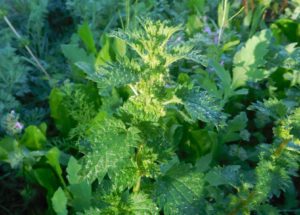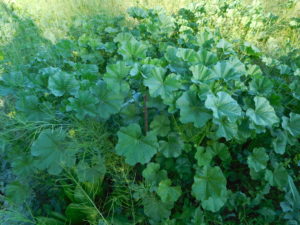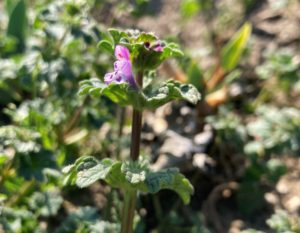These weeds grow fast, flower then produce abundant seeds for the next year. They are usually easy to pull out when small. It is important to remove them before they flower. Here are some of the most common ones found in gardens.
Spot ted spurge (Euphorbia maculata) is the most common of the several types of spurges found in our area. Plants grow close to the ground. They prefer warm temperatures and are commonly seen in late spring and summer. Each plant can produce several thousand seeds. New seedlings can be very small and hard to detect but grow rapidly. Usually easy to hoe or pull out but can be difficult to manage if there are many small plants. http://ipm.ucanr.edu/PMG/PESTNOTES/pn7445.html
ted spurge (Euphorbia maculata) is the most common of the several types of spurges found in our area. Plants grow close to the ground. They prefer warm temperatures and are commonly seen in late spring and summer. Each plant can produce several thousand seeds. New seedlings can be very small and hard to detect but grow rapidly. Usually easy to hoe or pull out but can be difficult to manage if there are many small plants. http://ipm.ucanr.edu/PMG/PESTNOTES/pn7445.html
 Burning nettle (Urtica urens) is well named due to the burning pain felt when touching the leaves. To relieve the pain, put some tape on the skin then pull it off to remove the tiny hairs. Prolific seed spreader from early germination. Use a hoe or other tool to remove and avoid touching the plant as much as possible. http://ipm.ucanr.edu/PMG/PESTNOTES/pn74146.html
Burning nettle (Urtica urens) is well named due to the burning pain felt when touching the leaves. To relieve the pain, put some tape on the skin then pull it off to remove the tiny hairs. Prolific seed spreader from early germination. Use a hoe or other tool to remove and avoid touching the plant as much as possible. http://ipm.ucanr.edu/PMG/PESTNOTES/pn74146.html
Little  mallow (Malva parviflora) also called cheeseweed grows rapidly during cool weather. They grow upright forming a small bush. The tap root can be large and grow very deep so it is very important to remove the plant early. http://ipm.ucanr.edu/PMG/PESTNOTES/pn74127.html
mallow (Malva parviflora) also called cheeseweed grows rapidly during cool weather. They grow upright forming a small bush. The tap root can be large and grow very deep so it is very important to remove the plant early. http://ipm.ucanr.edu/PMG/PESTNOTES/pn74127.html
 Common purslane (Portulaca oleracea) grows rapidly during warm weather and is a prolific seed spreader. A single plant can produce 240,000 seeds. The plant must be disposed of in trash as it can continue to produce seeds a week after being pulled out. Seeds are produced when plant is still small so early detection and removal is critical. http://ipm.ucanr.edu/PMG/PESTNOTES/pn7461.html
Common purslane (Portulaca oleracea) grows rapidly during warm weather and is a prolific seed spreader. A single plant can produce 240,000 seeds. The plant must be disposed of in trash as it can continue to produce seeds a week after being pulled out. Seeds are produced when plant is still small so early detection and removal is critical. http://ipm.ucanr.edu/PMG/PESTNOTES/pn7461.html
 Henbit (Lamium amplexicaule) is a small annual found commonly throughout the garden in winter and early spring. It can often be hidden around vegetables allowing plants to flower and produce seeds before they are noticed. Easily pulled out by hand or hoe. http://ipm.ucanr.edu/PMG/WEEDS/henbit.html
Henbit (Lamium amplexicaule) is a small annual found commonly throughout the garden in winter and early spring. It can often be hidden around vegetables allowing plants to flower and produce seeds before they are noticed. Easily pulled out by hand or hoe. http://ipm.ucanr.edu/PMG/WEEDS/henbit.html
 Dandelion, (Taraxacum officinale) is a perennial with a deep tap root that is hard to remove. The plant can grow back with just a small part of the root so complete removal is necessary. Seeds spread easily through the air and will impact neighboring gardens. http://ipm.ucanr.edu/PMG/PESTNOTES/pn7469.html
Dandelion, (Taraxacum officinale) is a perennial with a deep tap root that is hard to remove. The plant can grow back with just a small part of the root so complete removal is necessary. Seeds spread easily through the air and will impact neighboring gardens. http://ipm.ucanr.edu/PMG/PESTNOTES/pn7469.html
 Yellow sweetclover (Melilotus officinalis) is one of many clover varieties found throughout the garden. They can usually be hoed or pulled out. Seeds can last a long time in the soil. http://ipm.ucanr.edu/PMG/PESTNOTES/pn7490.html
Yellow sweetclover (Melilotus officinalis) is one of many clover varieties found throughout the garden. They can usually be hoed or pulled out. Seeds can last a long time in the soil. http://ipm.ucanr.edu/PMG/PESTNOTES/pn7490.html
